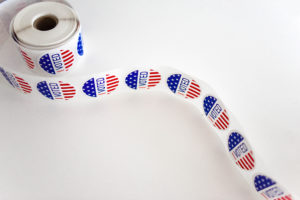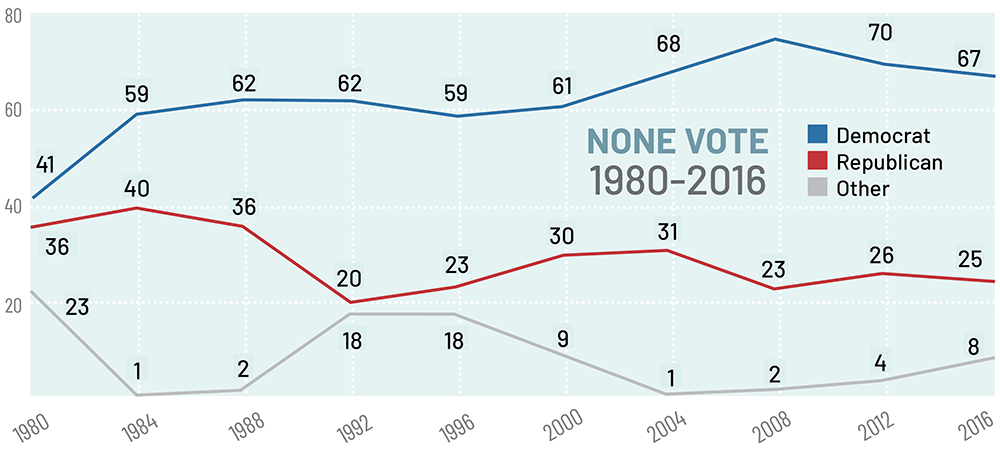NONEDECISION 2020 | Four Decades of the None Vote

Since 1980, the year Ronald Reagan was elected, there have been ten presidential elections. According to exit poll data in each of those elections, the majority of nones—people with no religious affiliation—have voted for the Democratic Party candidate. This preference has increased substantially in recent years; the 1980, 1984, and 1988 elections are the most “competitive” in terms of the margin of victory the Democratic candidates achieved among the nones. Elections in the 1990s (’92, ’96, and 2000) saw support for Republicans hit its lowest points, with nonreligious voters abandoning GOP candidates in large numbers. In the current century (2004, 2008, 2012, and 2016 elections), Democrats have reached their highest level of support from the nones so far.
In 1980 the incumbent Jimmy Carter, a Democrat running for reelection, received 41 percent of the none vote. His opponent and the winner of that election, former California governor Ronald Reagan, received 36 percent of the none vote. That five-percentage-point margin would be the closest a Republican presidential candidate would ever get to a Democrat among the nones. By 1984 the Republican share (for Ronald Reagan) increased to 40 percent, but the Democratic share (for former vice president Walter Mondale) was 59 percent in a year that Reagan won in a landslide. In 1988 the Democratic candidate, then Massachusetts governor Michael Dukakis, won a majority of the none vote (62 percent) while the winner, Vice President George H.W. Bush, received 36 percent of the none vote as the Republican candidate. This was the last time a Republican received at least one-third of the none vote.

The 1980 election is also a major example of another characteristic of the none vote, which is the high level of support for third-party and independent candidates. That year John B. Anderson, a Republican congressman from Illinois, ran as an independent and received nearly 7 percent of the popular vote and 12 percent of the independent vote. In 1980 nearly one-quarter of the nones (23 percent) voted for third-party or independent candidates, including 16 percent who voted for Anderson.
The 1990s were stable for Democratic candidates but can be considered the lowest point for Republican candidates in terms of support from the nones. The Democratic candidate in 1992, then Arkansas governor Bill Clinton, matched Dukakis’s performance four years earlier (62 percent). Four years later, 59 percent of nones voted for his reelection. On the Republican side, President George H.W. Bush received just 20 percent of the none vote in his 1992 reelection bid, while former Kansas senator Bob Dole, the 1996 Republican candidate, fared slightly better with 23 percent. The decade closed with Vice President Al Gore earning 61 percent of the none vote as the 2000 Democratic candidate, matching the performances of his predecessor. The 2000 Republican candidate, then Texas governor George W. Bush, improved on his father’s 1988 performance and received 30 percent of the none vote in winning the presidency.
Once again, the nones supported independent bids in large numbers in the 1990s. In 1992 businessman H. Ross Perot shocked the political world when he received 19 percent of the popular vote. The nones were part of that overall trend, with 18 percent voting for him. In 1996, when Perot ran again and received 8 percent of the vote, 13 percent of nones voted for him. Overall, 18 percent of secular voters supported third-party and independent candidates in 1996. In 2000, 7 percent of nones supported Green Party candidate Ralph Nader, who received 3 percent of the popular vote. Nine percent of nones voted for candidates outside of the two major parties.
In the four elections in this century, all the Democratic candidates have received at least two-thirds of the none vote. Then Massachusetts senator John Kerry received 68 percent of the none vote in 2004. Three-quarters (75 percent) of the nones supported then Illinois senator Barack Obama in his 2008 presidential bid and 70 percent supported him in his 2012 reelection. Finally, two-thirds (67 percent) supported former secretary of state Hillary Clinton in 2016. For Republicans, 2004 was a high mark; 31 percent of nones supported President George W. Bush for reelection, the highest since Reagan received 40 percent twenty years before. Since that election, Republican candidates have struggled to get 30 percent of the none vote. Then Arizona senator John McCain received 23 percent in 2008 and four years later, former Massachusetts governor Mitt Romney received 26 percent. Donald Trump received one-quarter of the none vote in 2016.
With the exception of 2016, twenty-first century elections have lacked the high-profile third party and independent candidate bids of the ’90s and most nones voted for the candidates from the two major parties. In 2016, 6 percent of Americans voted for an array of third-party and independent candidates, including former New Mexico governor Gary Johnson of the Libertarian Party, physician Jill Stein of the Green Party, and former intelligence officer Evan McMullin. Eight percent of nones voted for these and other candidates, the highest level of support for third-party candidates since 2000.
In 1980 the nones accounted for 7 percent of the US adult population according to the General Social Survey. Today the American Values Atlas produced by the Public Religion Research Institute (PRRI) estimates that one in four American adults are nones. As the group’s size has increased, its voting patterns have widened, becoming more Democratic-leaning in each decade. In the 1980s the Democratic candidate won by an average of 17 percentage points, increasing to 36 percentage points in the 1990s. This century the Democratic Party candidate gets a majority of the secular vote with an average advantage of 44 percentage points over the Republican candidate.
Only 5 percent of voters were nones in 1980, and they accounted for a small share of the parties’ coalitions. Just 4 percent of Reagan voters and 5 percent of Carter’s were nones. By 2016, 15 percent of exit-poll respondents were nones, less than one in ten of whom voted for Trump (8 percent) but represented one in five Clinton voters (21 percent). It should come to no surprise that as the power of the religious right in Republican Party politics became more evident, secular voters started fleeing. Since the power of Christian fundamentalists has become even more obvious during the current administration, expect the party gaps to remain—or even widen—in the near future.
